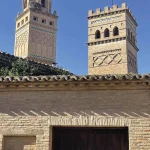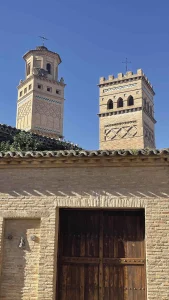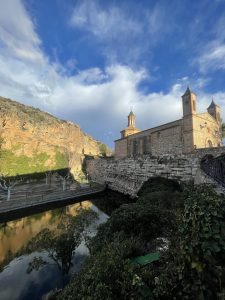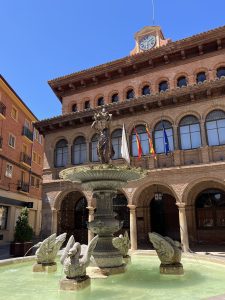


Mudetrad Project

El mudéjar y la geometría euclidiana

Didactic Mudejar, the guide

Circular from the rural school
Family Outings

The eighth milestone
The roots of this settlement can be traced back to the archaeological remains of a Roman villae near the eighth milestone of the military road that ran from Ilerda to Legio VII Gemina. This is why some research has linked the name Utebo with “octavus”.
The old quarter is centred around the church, the town’s main monument, in an organic and irregular manner, articulated around three main areas: the Plaza de España, the Cuatro Esquinas and the Plaza del antiguo Ayuntamiento.
In Utebo there are various architectural structures dating from the end of the 16th century and the beginning of the 17th century. All of them are made with traditional materials that could refer us to the Islamic tradition: brick plastered with plaster. This heritage is combined with new western artistic styles, generating an architecture with its own genuine characteristics, which we know as Aragonese Renaissance.
The roots of this settlement can be traced back to the archaeological remains of a Roman villae near the eighth milestone of the military road that ran from Ilerda to Legio VII Gemina. This is why some research has linked the name Utebo with “octavus”.
The old quarter is centred around the church, the town’s main monument, in an organic and irregular manner, articulated around three main areas: the Plaza de España, the Cuatro Esquinas and the Plaza del antiguo Ayuntamiento.
In Utebo there are various architectural structures dating from the end of the 16th century and the beginning of the 17th century. All of them are made with traditional materials that could refer us to the Islamic tradition: brick plastered with plaster. This heritage is combined with new western artistic styles, generating an architecture with its own genuine characteristics, which we know as Aragonese Renaissance.
"The bell tower of mirrors"
The tower, also known as the ‘belfry of mirrors’ because of the reflections and glints produced by the sun on the ceramics that cover it, is a magnificent example of late Mudéjar architecture and corresponds to the typology of the mixed tower. The date of completion of the work and its architect are known from an inscription on the first frieze of the square body, in the form of a decorative border: […] izola mestre Alonso de Leznes, acabose en año 1544.
The inscription is made in glazed ceramic from Muel, with a white background and the epigraphic characters in manganese oxide. Leznes was an outstanding master builder who also worked on the Lonja in Saragossa and the church in Longares.
The Mariano Mesonada Cultural Centre, in the Plaza de España, is a must. It houses a museum dedicated to the painter José Orús and hosts various cultural activities. Also the Centro Cultural El Molino, an old flour mill which has been given a new function as a municipal cultural space.
The tower, also known as the ‘belfry of mirrors’ because of the reflections and glints produced by the sun on the ceramics that cover it, is a magnificent example of late Mudéjar architecture and corresponds to the typology of the mixed tower. The date of completion of the work and its architect are known from an inscription on the first frieze of the square body, in the form of a decorative border: […] izola mestre Alonso de Leznes, acabose en año 1544.
The inscription is made in glazed ceramic from Muel, with a white background and the epigraphic characters in manganese oxide. Leznes was an outstanding master builder who also worked on the Lonja in Saragossa and the church in Longares.
The Mariano Mesonada Cultural Centre, in the Plaza de España, is a must. It houses a museum dedicated to the painter José Orús and hosts various cultural activities. Also the Centro Cultural El Molino, an old flour mill which has been given a new function as a municipal cultural space.
Territorio Mudéjar Network
The city council has been a full member of Territ estate Territ percibible since April 2022.
More information
Town Hall: 976 770 111
https://utebo.es/
VISIT UTEBO
976 633 296
DO YOU WANT TO KNOW MORE?
Turismo de Aragón
turismodearagon.com
Turismo Comarca Central
https://comarcacentral.es/
Projects Territorio Mudéjar in Utebo
Pedagogy | See project
Mudetrad project | See project
Mudéjar and Euclidean geometry | See project
Mudéjar didactic, the guide | See project
“Circular” Family walks | See project
The wall as dermis. Light in the Mudéjar | See the project











